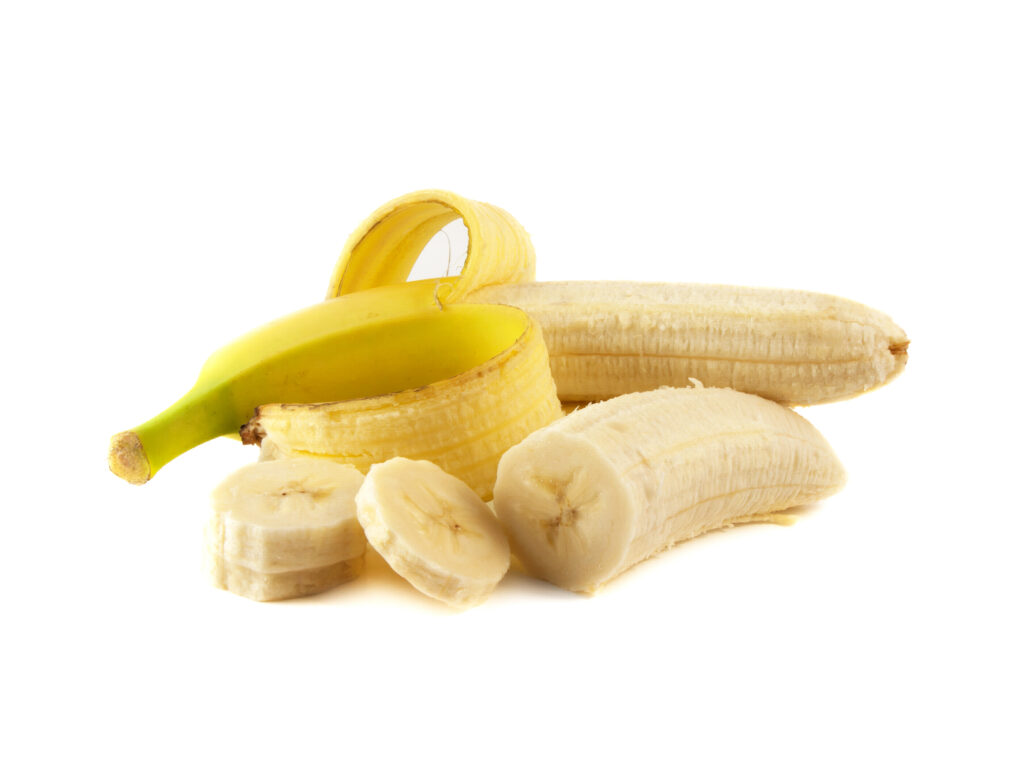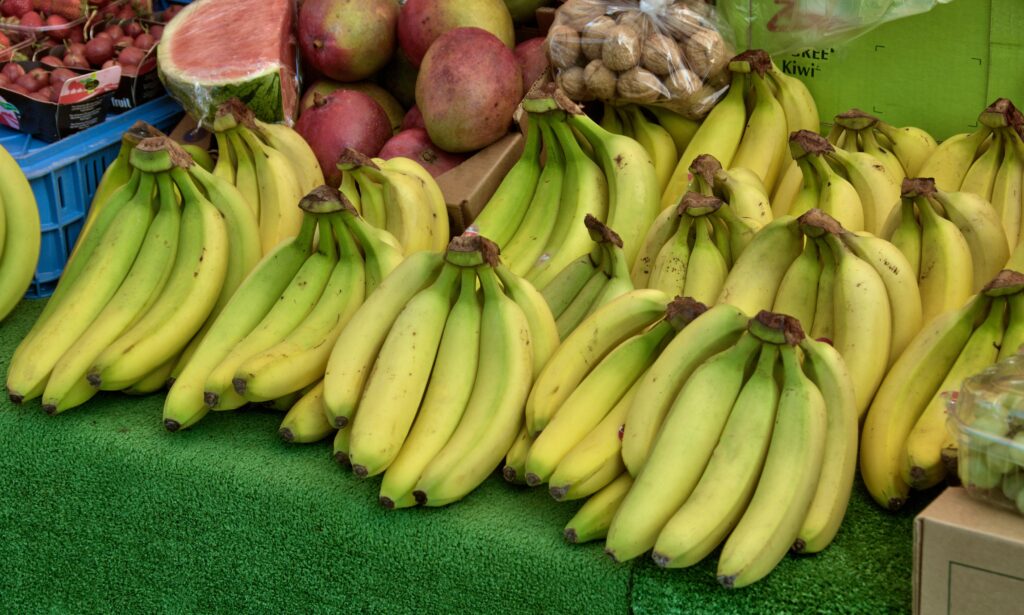Banana
Crooked paths to enjoyment: sustainability in banana cultivation
“Why is the banana crooked?” – Hardly a question is more common in the vernacular and the answer is quite simple. The reason for the curvature is that bananas change direction as they grow. If the fruits initially hang downwards, they bend upwards in the direction of the light as they grow on the plant.
General information
The dessert banana with the botanical name Musa x paradisica belongs to the banana family, Musaceae. The name banana is probably derived from the Arabic word “banan”, which means finger. Botany, which classifies the banana as a berry, provides an interesting insight. In Germany, these berries are extremely popular, second only to apples when it comes to fruit consumption. This is also due to the vitamins, minerals, sugar and fiber that bananas contain. We are taking a closer look at these healthy fruits below.

Growing regions
The banana originated in the Malay Archipelago and came to Africa via Indonesia and Madagascar. From there, it was first transported to the Caribbean islands by Spanish sailors and finally reached South America in the Middle Ages. Most of the fruit found in supermarkets today comes from South or Central America, especially Colombia, Costa Rica and the Dominican Republic. In addition to the countries mentioned above, bananas are also grown in Asia, particularly in China, India, Indonesia and the Philippines, as well as in African countries such as Ghana, Nigeria, Cameroon, Angola and Tanzania.
Cultivation and harvest
Bananas are mainly grown in the tropics and subtropics, where the climate is consistently warm with an average annual temperature of at least 20°C and well-distributed annual rainfall of 2000 to 2500 mm. Banana plants also need plenty of light and little wind. The soil should be loose, with a pH value of 5.5 to 6.5, and the topsoil should contain plenty of organic material.
While the small farmers mainly produce for local consumption, most of the harvest from the larger farms is exported. Harvesting usually takes place in pairs: One person cuts off the top of the banana plant and the second person carries the fruits, which weigh 50kg on average, to a cableway between the rows of bushes. From there, they are taken directly to the packing station, where they are washed and pesticides are removed. The fruit is then sorted and divided into manageable bundles. Finally, the bananas are packed into crates and prepared for transportation.


Consumption
In Germany alone, the annual per capita consumption of bananas is 12.4 kg, putting it in second place, just behind apples. The European Union is even the largest importer of fruit bananas with 5.2 million tons per year. Interestingly, bananas are also grown in Europe (e.g. in Madeira and Guadeloupe), which covers 10% of the European demand. It should be noted that a distinction can be made between fruit bananas and plantains.
In Germany, bananas are mainly consumed as fruit bananas and as a snack. In comparison, in other countries the plantain covers around 12–27% of the daily calorie requirement. The plantain is considered more of a vegetable and is mostly consumed in the countries where it is grown. The Cavendish variety of fruit banana is the most widely cultivated kind because of its taste, resistance to fungi and favorable growing conditions. In general, many more bananas are consumed in the countries where they are grown than in other countries; for example, of the 100 million tons of bananas harvested, only 16 million tons are exported.
Certification
In German supermarkets, you will mainly find stickers from three certification organizations on bananas: Organic, Fairtrade und Rainforest Alliance are the most widespread in this country. However, there are also smaller organizations such as Banafair. According to its own information, this certification can only be found on organic bananas and other products from Latin America that originate from smallholder production. It covers a much smaller market segment than the above-mentioned labels and is mainly found in organic or village stores. Basically, the labels stand for minimum social and ecological standards that have been adhered to in the cultivation of bananas.
This should not be viewed entirely uncritically in the case of certified bananas and the requirements and control systems also vary from organization to organization. There are reports of abuses on banana plantations. It should also be noted that workers on certified plantations sometimes do not receive higher wages than on non-certified plantations. On the other hand, working conditions are better on certified plantations, especially in terms of job security. Certifications are therefore not useless. They initiate efforts towards environmentally conscious cultivation and improve the conditions of workers on the plantations, even if there is still a lot of room for improvement in both areas.


Challenges
Climate change is a global challenge, which will also have an impact on banana cultivation. In important banana-growing regions such as India, Costa Rica and Colombia, temperatures will exceed the optimal warmth for banana growth. In addition, extreme weather events such as hurricanes will increase and cause major damage to plantations. The outlook is anything but rosy, but these are not the only problems. In addition to climate change, there are also countless diseases and banana pests that can attack banana plants.
These have been spreading faster and faster over the last century and represent a major challenge, as well as a loss of profit for the banana industry. To counteract this, attempts are being made to breed new species that are resistant to these threats. In addition, controls, disinfection systems and drones are to help in the fight against pests. An enormous effort is being made to ensure that the banana remains an important export commodity.
Sustainability
The issue of sustainability does not stop at the banana either. As already mentioned above, the perennial has to contend with many diseases. A large amount of pesticides is often required to counteract these. Therefore, different methods of pest and disease control should be found that are ideally organic and do not endanger human or soil health. Another possibility would be to breed new varieties that are more resistant to diseases and heat. In some regions, bananas have to contend with drought, which means extreme stress for the plants. It is therefore very important to look into efficient irrigation systems.
In addition, one of the best ideas would be to return to a traditional cultivation method. This method is often practiced by small farms in particular. Different plants such as avocado, grapefruit, coffee or bananas are grown together. The farmer needs less mineral fertilizer and therefore obtains better and healthier products.
The social aspect is also extremely important for sustainable cultivation. Here, higher wages and better social benefits for workers should be introduced and further expanded. We consumers also need to be mindful. After all, through our purchases, we are making a key contribution to giving sustainable farmers the opportunity to stand a chance in the competitive market.
Therefore: keep your eyes open when buying bananas!
